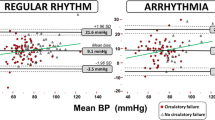Abstract
Background. There are few suitable methods for monitoring blood pressure continously (or intermittently) for research in adult stroke patients, who are ill but do not justify invasive intensive care monitoring. Method. We tested a neonatal arm blood pressure in adults by placing it on the forefinger (“finger cuff”). We compared the repeatability of the finger cuff with blood pressure measured by a standard adult arm cuff using the oscillometric technique in 168 ambulatory outpatients attending a cerebrovascular disease clinic. Results. The mean difference between sequential mean blood pressure readings with the finger cuff was 0.55 mm Hg (95% confidence interval (CI) −14.36 to 15.47 mm Hg), and for the arm cuff was 3.31 mm Hg (95% CI −23.33 to 16.71 mm Hg). Measurements made with the arm cuff were shown to affect subsequent arm cuff readings made within a few minutes of the first. The mean difference between the finger cuff and arm cuff mean blood pressure readings was 0.03 mm Hg (95% CI −26.07 to 26.14 mm Hg) and agreement was better when the blood pressure was measured with the finger cuff first rather than the arm cuff. However, although there was no difference in the mean blood pressure recordings both systolic and diastolic blood pressure measurements differed systematically between arm and finger cuff. Conclusion. The reproducibility of sequential blood pressure measurements made with the finger cuff was better than with the arm cuff. The performance of the finger cuff compared with that of the arm cuff was sufficiently good to encourage use of the finger cuff in research involving automatic intermittent monitoring to observe sequential blood pressures over time in stroke patients. However, measurements of systolic and diastolic pressure were not the same with the two cuffs and further work on calibration of the finger cuff would be useful.
Similar content being viewed by others
REFERENCES
Stanton A, O'Brien E. Non-invasive 24 hour ambulatory blood pressure monitoring: current status. Postgrad Med J 1993; 69: 255–267
Triedman JK, Saul JP. Comparison of intra-arterial with continuous blood pressure measurement in postoperative paediatric patients. J Clin Monit 1994; 10: 11–20
Lal KLS, Henderson RJ, Cejnar M, Hart MG, Hunyor SN. Physiological influences on continuous finger and simultaneous intra-arterial blood pressure. Hypertension 1995; 26: 307–314
Omboni S, Parati G, Frattola A, Mutti E, Rienzo M, Castiglioni P, Mancia G. Spectral and sequence analysis of finger blood pressure variability. Hypertension 1993; 22: 26–33
Yelderman M, Ream AK. Indirect measurement of mean blood pressure in the anaesthetised patient. Anaesthesiology 1979; 50: 253–256
Borow KM, Newburger JW. Non-invasive estimation of central aortic pressure using the oscillometric method for analysing systemic arterial pulsatile blood flow: Comparative study of indirect systolic, diastolic and mean brachial artery pressure with simultaneous direct ascending aortic pressure measurements. Amer Heart J 1982; 103: 879–886
O'Brian E, Petrie J, Littler W, de Sweit M, Padfield PL, O'Malley K, Jamieson M, Altman D, Bland M, Atkins N. The British Hypertension Society protocol for the evaluation of automated and semi-automated blood pressure devices with special reference to ambulatory systems. J Hypertension 1990; 8: 607–619
Davis RF. Clinical comparison of automated auscultatory and oscillometric and catheter-transducer measurements of arterial pressure. J ClinMonit 1985; 1: 114–119
Petrie JC, O'Brien ET, Littler WA, de Sweit M. British Hypertension Society: Recommendations on blood pressure measurement. Br Med J 1986; 293: 611–615
British Hypertension Society. Blood pressure measurement. Human Hypertension 1985; 3: 293
Frohlich ED, Grim C, Labarthe DR, Maxwell MH, Perloff D, Weidman WH. Recommendations for human blood pressure determination by sphygmomanometers. Hypertension 1988; 11: 209–22A
Russell AE, Wing LMH, Smith SA. Optimal size of cuff bladder for indirect measuremetn of arterial pressure in adults. J Hypertension 1989; 7: 607–614
Croft PR, Cruickshank JK. Blood pressure measurement in adults: large cuffs for all? J Epidemiol Comm Health 1990; 44: 170–173
Kurki T, Smith NT, Head N, Dec-Silver H, Quinn A. Non-invasive continuous blood pressure measurement from the finger: Optimal measurement conditions and factors affecting reliability. J Clin Monit 1987; 3: 6–13
Webster J, Newnham D, Petrie JC. Influence of arm position on measurement of blood pressure. Br Med J 1984; 288: 1574–1575
Ramsay M. Automatic oscillometric NIBP versus manual auscultatory blood pressure in the PACU. J Clin Monit 1994; 10: 136–139
Author information
Authors and Affiliations
Rights and permissions
About this article
Cite this article
Khan, S.Q., Wardlaw, J.M., Davenport, R. et al. Use of A Neonatal Blood Pressure Cuff to Monitor Blood Pressure In The Adult Finger – Comparison With A Standard Adult Arm Cuff. J Clin Monit Comput 14, 233–238 (1998). https://doi.org/10.1023/A:1009934032524
Issue Date:
DOI: https://doi.org/10.1023/A:1009934032524




